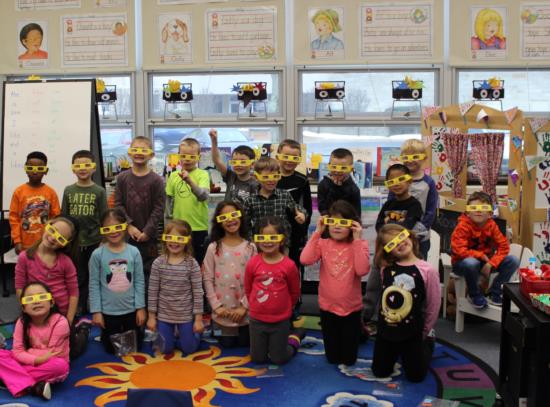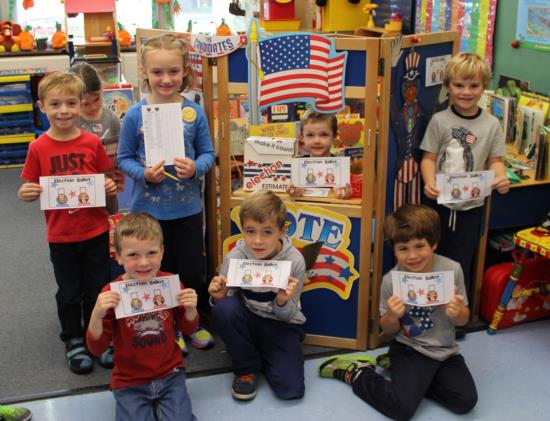Welcome to Kindergarten!

Kindergarten students do not wear uniforms. Comfortable clothes and non-marking rubber-soled closed-heel-and-toe shoes (no sandals permitted) suitable for activity are required. The school haircut and nail polish policies apply to kindergarten students. Kindergarten students have a snack each day, which parents are asked to send from home. Thank you for helping us to make this a happy and successful beginning of school for all of our kindergarten students.

READINESS TIPS
THE FOLLOWING IS A LIST OF SUGGESTIONS THAT ARE INTENDED TO HELP PREPARE YOUR CHILD FOR KINDERGARTEN. THE LIST INCLUDES SOME SIMPLE IDEAS THAT YOU CAN PRACTICE WITH YOUR CHILD OVER THE NEXT FEW MONTHS BEFORE THE BEGINNING OF THE UPCOMING SCHOOL YEAR:
LITERACY SKILLS
*Read aloud to your child
*Read rhyming books and predictable texts
*"Play" with sounds such as: substituting the beginning sound in his or her name with other sounds
*Visit the local libraries for storytelling
*Encourage your child to write
*Provide fun writing materials such as markers, large crayons, assorted paper, and envelopes
*When printing his or her name encourage your child to pring the first letter in uppercase, and remaining letters in lowercase
*Use "Environmental Print" to reinforce that print is everywhere in our world
MATH SKILLS
*Point out the colors, shapes and numbers in the environment with "I spy"
*Read concept books that focus on colors, shapes and numbers
*Practice counting and sorting skills such as: counting toys, or everyday items such as buttons or paperclips
*Have your child touch each object as he/she is counting
*Help to develop calendar skills by: referring to the days of the week, the date, or even counting down the days to an upcoming event
*Play games such as: "Go Fish", dominoes, matching games, or games where your child has to roll dice and count to play the game
FINE MOTOR DEVELOPMENT
*String beads, or even cereal to make necklaces
*Use play dough to roll and shape letters or make objects
*Put together puzzles
*Use scissors to cut along straight, wavy or zigzag lines, or cut out coupons
*Encourage your child to play with Legos, Tinker toys, or other small building blocks
*Provide art supplies that encourage creativity and fine motor development such as: markers, crayons, watercolor paints, scissors, and glue
LARGE MOTOR DEVELOPMENT
*Some great outdoor summer games are: Hop Scotch, jump rope, hula hoops, riding a tricycle or bicycle, and playing catch
*Encourage your child to skip, hop on one foot, bounce a ball, or clap their hands to music
RELIGION
*Help your child to become familiar with the following:
The Sign of the Cross
The Our Father and The Hail Mary
Grace before eating snacks and meals
SOCIAL AND SELF-HELP SKILLS
*Provide opportunities for your child to play with other children
*Encourage your child to share, take turns, and play cooperatively
*Establish a daily routine to make the transition to kindergarten smoother
*Have your child practice emergency information such as: saying his or her full name, address and telephone number
*Encourage your child to button, fasten, and zip his or her own clothing, and tie his or her shoes
*Have your child get in the habit of putting his or her toys and belongings away to encourage responsiblity and independence
MORE TIPS FOR PREPARING YOUR CHILD
FOR KINDERGARTEN
The following are some activities you can do and skills you can practice with your child to help prepare him or her for kindergarten:
General Enrichment:
These activities increase a child’s store of information about the world and enable a child to view the people and events around him or her from many different perspectives. These activities help a child develop a sense of awareness, ability and belonging:
- Read to your child as often as possible.
- Take your child to the library. Get him or her a library card.
- Visit zoos, farms, museums, and the like, and discuss the sights.
- Talk with your child about his or her interests and experiences. Compose stories together.
- Allow your child to help plan family outings. Make him or her responsible for at least one aspect of the day’s activities.
- Give your child many opportunities to play with other children.
- Take your child swimming, picnicking, or camping with family and friends.
Care of Person:
- Wiping nose with a tissue.
- Brushing teeth.
- Combing hair with own comb and brush.
- Tying shoe laces – practice with own or another’s shoe or a play shoe).
- Putting on outer clothes.
- Using buttons and zippers.
- Adjusting pants or dress.
- Putting on boots.
Following Directions:
Make games out of these activities. Teach and practice these directions with your child. Do one at a time and when the child has learned one direction, add another until the child has learned all directions and can follow instructions:
- Sitting, standing, jumping, clapping hands, waiting.
- Walk, skip, run.
- Bounce, throw, catch a large ball.
- Bend down, reach for something.
- Opening and closing door or drawer.
- Follow the leader.
- Sitting up tall, resting head on table, etc.
Helping at Home:
This area is particularly important in developing a sense of belonging and responsibility in your child. Certain tasks should be assigned to the child – perhaps a job sign-up process could be conducted involving all children in the home. Children enjoy opportunities to help. Let them know their help is needed.
- Carrying a water glass to the table.
- Carrying a small pitcher to the table.
- Watering a plant.
- Washing fruit for eating.
- Carrying a tray with some dishes.
- Cleaning table with a sponge or dish cloth.
- Clearing table of dishes.
- Folding napkins and placing them in position.
- Putting utensils in place.
- Dusting furniture.
- Picking up papers from the floor.
- Emptying wastebaskets.
- Helping load dishwasher.
- Finding correct letter of the alphabet in phone book.
- Helping measure ingredients for baking.
- Matching colors for clothing.
Traveling:
Let the child try simple short experiences until he or she has mastered them. Add further experiences to the ones learned.
- Daily or weekly trip with parent when shopping is being done. Allow your child to select produce when appropriate.
- Visits to relatives, friends, etc. Let child ring doorbell or knock.
- Experiences in restaurants with parents. Allow your childom the child when teaching listening skills. Make the listening experience one of pleasure, rather than a task. Repeat many of the stories and music so the child gains recognition of them. Stories, rhythms, etc. are important parts of a child’s world. Start with simple items and try to have the child repeat the story. Try also to have the child respond bodily (dancing, swaying, tapping) to the rhythm. Invent stories with the child. Illustrate them with the child.
- Stories (read to him or her).
- Music (use children’s recordings).
- Interacting with adults (try to bring the child into conversation by asking an occasional question).
- Listening to comparisons (big/little, etc.) Give the child as much language experience as is possible for him or her to comprehend.
Playing:
- At home, string beads and macaroni, do finger painting, play with water, build with blocks, play with jigsaw puzzles, cut with blunt scissors.
- On the playground, swing, play ball, climb the jungle gym, do jumping jacks, skip, etc.
Language:
These language activities should come out of play. The simpler the language, the greater will be the child’s understanding:
- Teach words of description: raining, snowing, jumping, sitting, rocking, dirty, clean, sticky, etc.
- Give a series of directions, starting with brief one-point directions, then a more involved sequence of directions.
- Teach words indicating directions: up, down, beside, over, under, on top of, behind, inside, etc.
- Learn nursery rhymes.
- Do dramatic play with puppets, dolls or dressing up; encourage your child to talk and verbalize.
- Talk about similarities and differences (ice is cold, boiling water is hot, etc.)
- Think of a new answer or solution to a problem (“what else could happen?")
Miscellaneous:
Visit the school to become familiar with the surroundings. Play on the playground. Peek in the windows.
Help your child know his or her name, address and phone number.
Show an interest in the new things your child is learning.